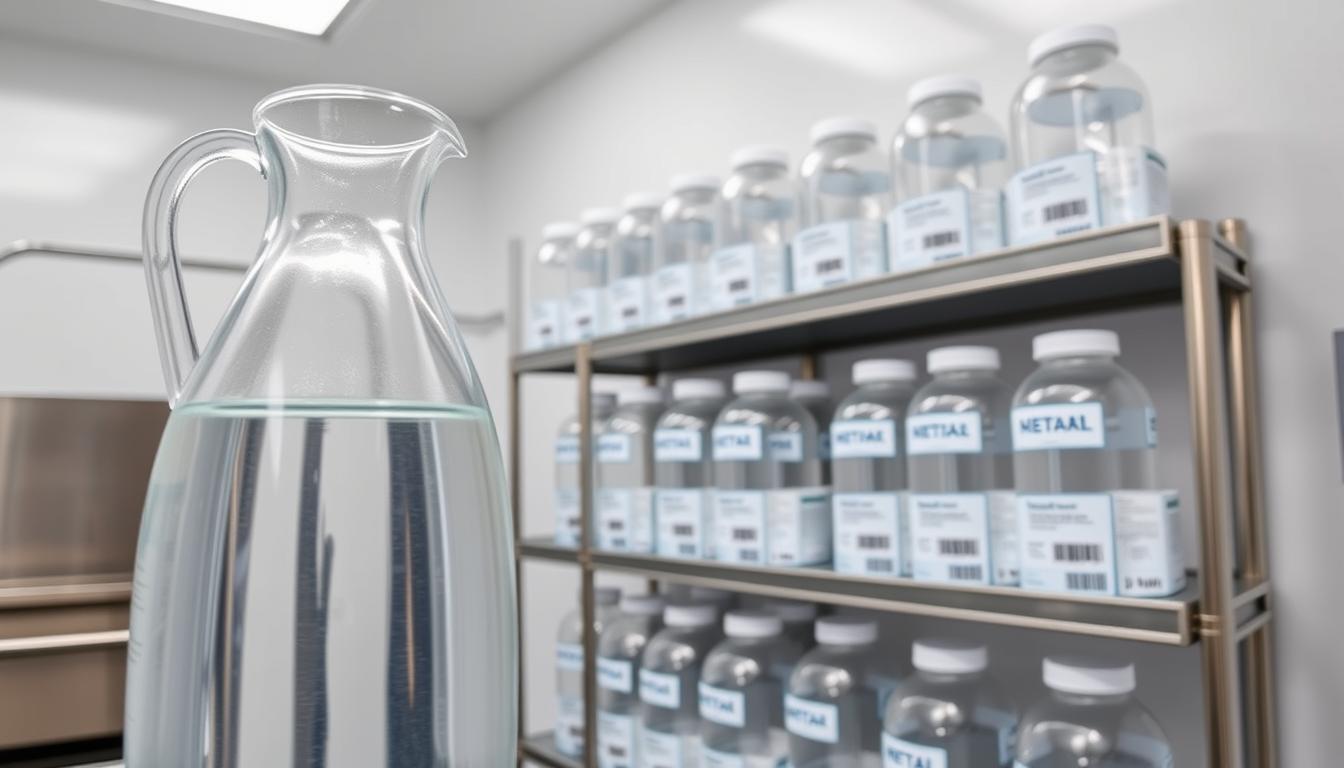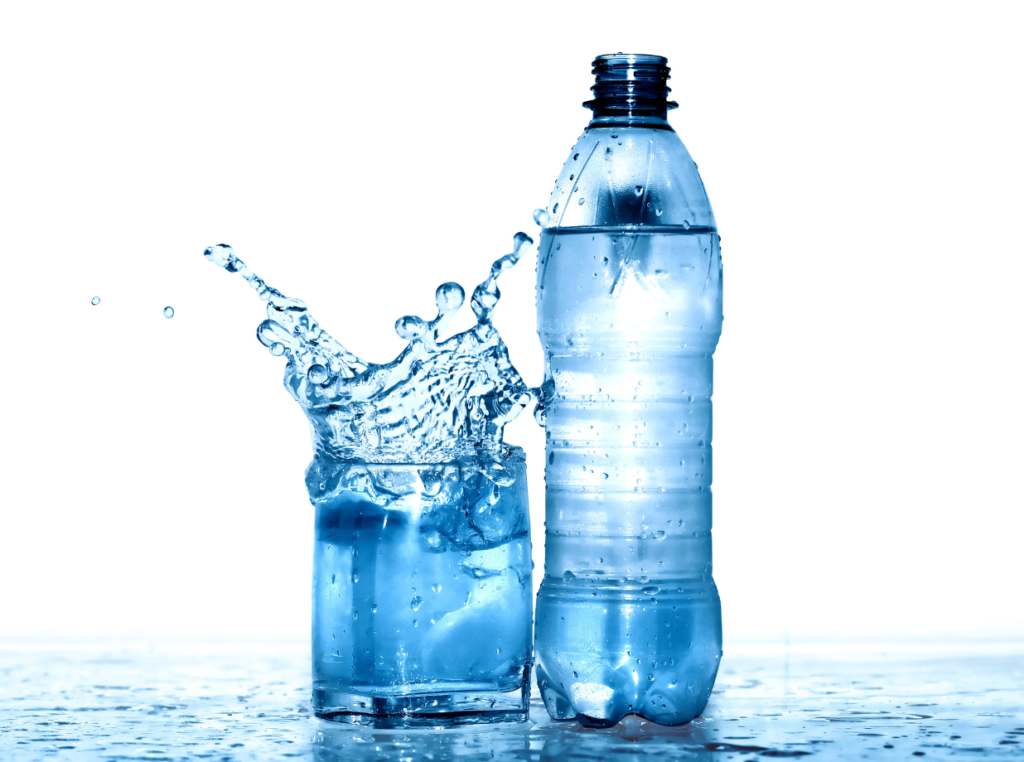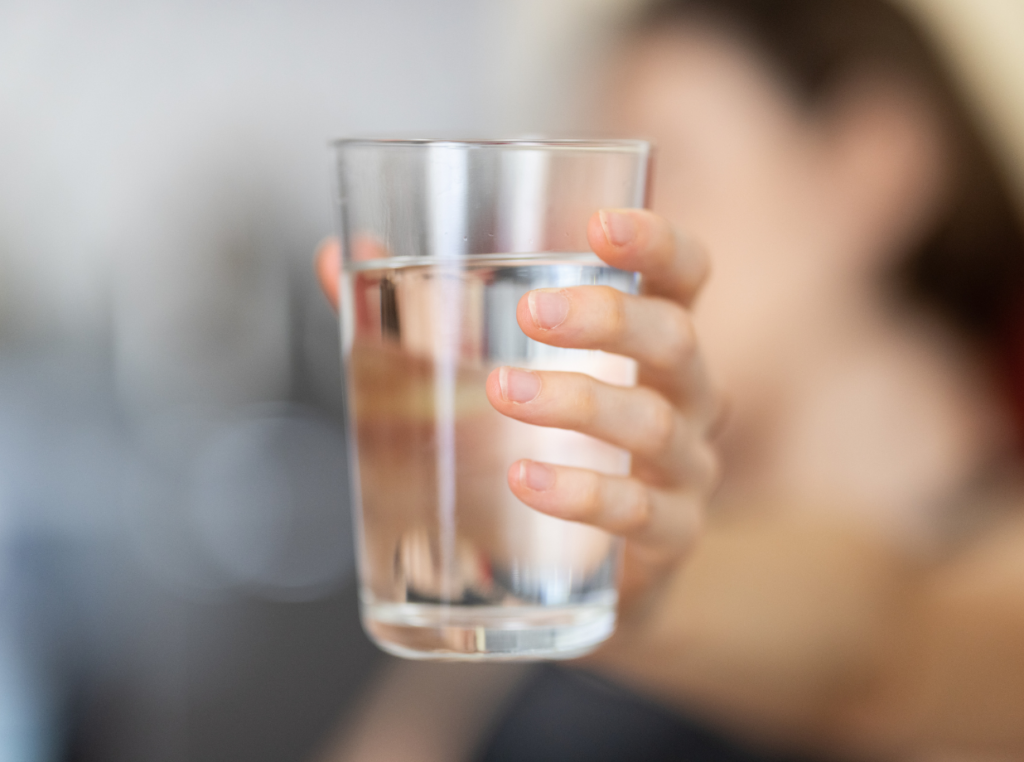Is your distilled water storage method compromising its purity? Many of us assume that distilled water remains clean indefinitely, but that’s not always the case.
When stored correctly, distilled water can last indefinitely and remain safe for consumption. However, exposure to heat, contaminants, or improper containers can affect its quality.
So, what’s the right way to store distilled water? The key lies in using the right containers and keeping them away from potential contaminants.
Key Takeaways
- Use sealed containers to store distilled water.
- Keep containers away from heat sources.
- Avoid exposure to contaminants.
- Regularly inspect stored water for signs of contamination.
- Use containers that are clean and sterile.
Understanding Distilled Water and Its Purity
Understanding the nuances of distilled water is crucial for maintaining its purity and effectiveness. Distilled water is purified through a process of distillation, which removes impurities, minerals, and contaminants, making it ideal for various applications.
What Makes Distilled Water Different
Distilled water stands out due to its purification process. Unlike other types of water, distillation involves boiling the water and then condensing it back into a liquid, leaving many contaminants behind. This process results in water that is very pure.
Why Purity Matters in Distilled Water
The purity of distilled water is crucial for its intended uses, such as in medical, laboratory, and certain industrial applications. In these contexts, using water that is free from contaminants is essential for achieving accurate results and ensuring safety.
- Medical applications require pure water to prevent infections.
- Laboratory tests demand pure water to ensure accurate results.
- Industrial processes use distilled water to maintain product quality.
Common Misconceptions About Distilled Water
There are several misconceptions about distilled water, including the belief that it is completely mineral-free and that it is not suitable for drinking. While it is true that distillation removes minerals, it is also an effective method for removing harmful contaminants. However, for drinking purposes, some may prefer water that contains minerals for taste and health reasons.
Why Proper Storage of Distilled Water Is Essential
Distilled water’s purity is highly susceptible to its storage conditions, making proper storage essential. When stored improperly, distilled water can become contaminated, losing its purity and potentially becoming unsuitable for its intended use.
Contamination Risks for Improperly Stored Distilled Water
Improper storage can lead to contamination through various means, including exposure to air, light, and contact with materials that can leach chemicals into the water. For instance, storing distilled water in containers that are not designed for long-term storage can result in the absorption of substances from the container, compromising the water’s quality.
Common Uses That Require Maintained Purity
Distilled water is used in various applications where purity is paramount, such as in medical facilities, laboratories, and for certain household appliances. Maintaining its purity through proper storage is crucial to ensure it remains effective and safe for these uses.
The Science Behind Water Degradation
The degradation of distilled water is often a result of its interaction with the environment and its storage container. Factors such as temperature, light exposure, and container material can influence the rate of degradation, highlighting the need for careful consideration in storage practices.
Choosing the Right Containers for Distilled Water Storage
Selecting the appropriate container is crucial for maintaining the purity of distilled water. The container’s material and design can significantly impact the water’s quality over time.
Best Container Materials for Long-Term Storage
The choice of container material is vital for storing distilled water effectively. Different materials offer various benefits and drawbacks.
Glass Containers: Pros and Cons
Glass containers are a popular choice due to their non-reactive nature. They don’t impart flavors or chemicals to the water, maintaining its purity. However, they can be heavy and prone to breakage.
HDPE Plastic Options
High-Density Polyethylene (HDPE) plastic containers are another recommended option. They are durable, resistant to chemicals, and less likely to leak. It’s essential to ensure they are food-grade to avoid contamination.
Stainless Steel Considerations
Stainless steel containers are durable and can be a good option, but they may react with certain substances. It’s crucial to choose containers that are specifically designed for storing drinking water.
Containers to Avoid and Why
Not all containers are suitable for storing distilled water. Containers made from PVC or those that contain BPA should be avoided due to the risk of chemical leaching.
Size Considerations Based on Usage Needs
The size of the container should be based on the intended use. Larger containers are suitable for household needs, while smaller ones are better for personal or emergency use.
By choosing the right container and following proper storage techniques, you can effectively maintain the purity of your distilled water. This ensures that the water remains safe and clean for its intended use.
How to Store Distilled Water Properly to Maintain Purity
To keep distilled water pure, it’s essential to follow the right storage guidelines. Proper storage is crucial to maintaining the purity and effectiveness of distilled water. This involves a series of steps that ensure the water remains contaminant-free and retains its quality over time.
Initial Container Preparation Steps
Before filling containers with distilled water, they must be thoroughly cleaned and dried. Use hot soapy water to wash the containers, followed by a thorough rinse with clean water. Sterilize the containers by submerging them in a solution of 1 part unscented bleach to 10 parts water for at least 30 minutes. After sterilization, allow the containers to air dry completely to prevent any water spots or bacterial growth.
Filling Techniques to Minimize Contamination
When filling the prepared containers with distilled water, it’s crucial to minimize exposure to air and contaminants. Use a clean funnel to pour the distilled water into the container, and avoid touching the inside of the container or the funnel to prevent introducing bacteria or other contaminants. Fill the containers to the top to reduce the amount of air in the container.
Sealing Methods for Maximum Protection
Once the containers are filled, they must be sealed properly to prevent contamination. Use tight-fitting lids that are designed for the containers you are using. Ensure the lids are clean and dry before sealing the containers. For added protection, consider using containers with tamper-evident lids or seals.
Labeling and Dating Your Stored Water
After sealing the containers, label them clearly with the date they were filled and the contents (“Distilled Water”). This helps in keeping track of how long the water has been stored and ensures that you use the oldest stock first. Use a permanent marker to write on the label to prevent the ink from fading over time.
Optimal Environmental Conditions for Storing Distilled Water
To keep distilled water pure, it’s crucial to control the conditions in which it’s stored. The environment where distilled water is kept can significantly affect its quality and purity.
Temperature Considerations
The ideal storage temperature for distilled water is between 59-77°F (15-25°C). It’s essential to store distilled water away from heat sources, such as heaters, ovens, or direct sunlight, as high temperatures can encourage bacterial growth and contamination.
Light Exposure Management
Distilled water should be stored in a dark or dimly lit area to prevent light from promoting the growth of algae or other microorganisms. Using opaque or dark containers can also help in minimizing light exposure.
Humidity and Air Quality Factors
High humidity can lead to moisture accumulation on containers, potentially causing labels to deteriorate or encouraging mold growth. Storing distilled water in a dry area with good air circulation can help mitigate these risks.
Best Storage Locations in Your Home
Considering the factors mentioned above, ideal locations for storing distilled water include a cool, dry basement or a pantry away from direct sunlight and heat sources. Avoid storing distilled water near chemicals or fuels, as these can contaminate the water through the container or air.
By controlling the environmental conditions, you can effectively maintain the purity of your stored distilled water. Following these distilled water storage tips ensures that your water remains safe and pure for its intended use.
The Shelf Life of Distilled Water: Facts and Myths
The longevity of distilled water is directly tied to its storage conditions, a fact often overlooked. Proper storage is key to maintaining its purity and effectiveness over time.
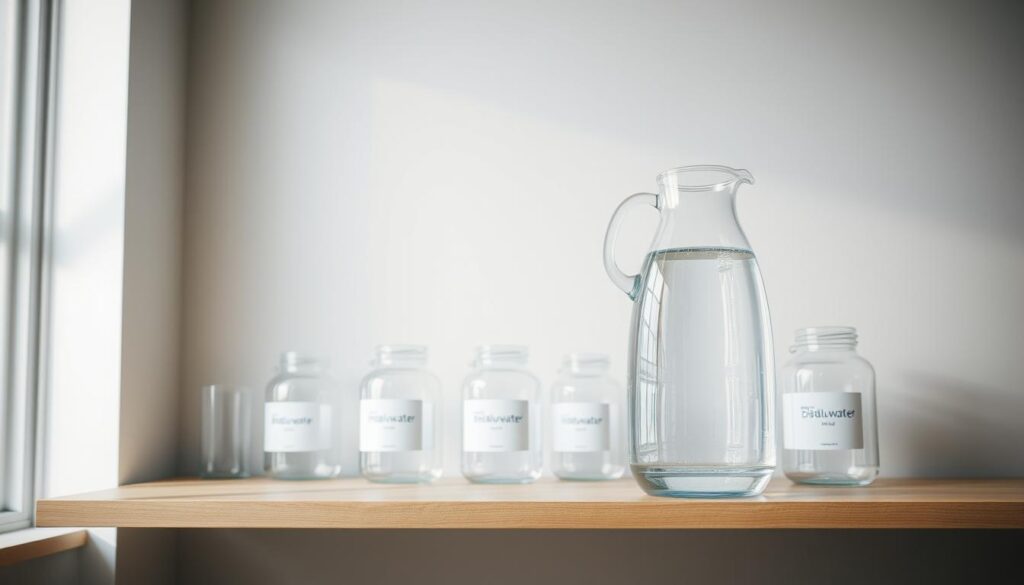
How Long Distilled Water Actually Lasts
Distilled water can last indefinitely when stored properly. The absence of minerals and impurities makes it less susceptible to bacterial growth, but it’s not entirely immune to contamination. Proper storage techniques are crucial to prevent degradation.
Signs That Stored Water Has Degraded
Signs of degradation include visible sediment, off-odors, or a change in taste. If the water is stored in a container that is not properly sealed, it may absorb CO2 from the air, making it acidic. Regular inspection is necessary to identify these changes early.
“The quality of stored distilled water is only as good as its storage container and the conditions it’s kept in.”
Extending Shelf Life Through Proper Techniques
To extend the shelf life, distilled water should be stored in a clean, airtight container, protected from light and kept in a cool, consistent temperature environment. Using the right materials for the container, such as glass or food-grade plastic, is vital.
When to Replace Your Stored Water
Even with proper storage, it’s recommended to replace stored distilled water every 6 to 12 months. This ensures that the water remains pure and effective for its intended use, whether it’s for drinking, laboratory use, or other applications.
By understanding the factors that influence the shelf life of distilled water and following best practices for storing distilled water, you can maintain its purity and effectiveness over time.
Special Storage Considerations for Different Uses
Distilled water is used in various applications, each requiring unique storage considerations to maintain its purity. The diverse uses of distilled water necessitate a tailored approach to storage to ensure its quality and effectiveness.
Medical and Health Applications
In medical settings, distilled water is used for various purposes, including CPAP machines, nasal irrigation, and wound care. For these applications, it’s crucial to store distilled water in a way that prevents contamination.
CPAP and Medical Device Requirements
For CPAP machines and other medical devices, distilled water should be stored in sterile containers to prevent bacterial growth. Regularly cleaning and drying the containers is also essential.
Nasal Irrigation and Wound Care
For nasal irrigation and wound care, using distilled water that is free from contaminants is vital. Storage containers should be cleaned and sanitized regularly to prevent the growth of bacteria or mold.
Automotive and Battery Uses
In automotive applications, particularly for batteries, distilled water is used to maintain the electrolyte balance. Storage containers for this purpose should be resistant to corrosion and leakage.
Laboratory and Scientific Requirements
Laboratories require distilled water of the highest purity for experiments and analyses. Storage containers for laboratory use should be made of materials that do not contaminate the water, such as glass or certain plastics.
Household Appliance Needs
For household appliances like steam irons and humidifiers, distilled water can help prevent mineral buildup. Storage for these applications should be convenient and accessible.
By understanding the specific storage needs for different applications of distilled water, individuals can ensure they are using the purest water possible for their intended use. Whether for medical, automotive, laboratory, or household purposes, proper storage is key to preserving distilled water quality and storing purified water effectively.
- Use appropriate containers based on the intended application.
- Regularly clean and sanitize storage containers.
- Consider the material of the container to prevent contamination.
Common Mistakes When Storing Distilled Water
Many people unknowingly compromise the purity of their distilled water through improper storage techniques. Maintaining the purity of distilled water is crucial for its intended use, whether it’s for drinking, laboratory purposes, or other applications.
Cross-Contamination Issues
One of the most significant mistakes is cross-contamination. This occurs when the distilled water comes into contact with contaminants from other substances or surfaces. For instance, using a container that previously held a different liquid without proper cleaning can introduce foreign substances into the distilled water.
Prevention Tips:
- Always use clean equipment and containers.
- Sanitize containers before filling them with distilled water.
- Keep the storage area free from potential contaminants.
Improper Container Reuse
Reusing containers without proper sterilization can lead to contamination. Some materials may also leach chemicals into the water, especially if the container is not designed for storing water.
Best Practice: Use containers specifically designed for water storage, and ensure they are thoroughly cleaned and sanitized before reuse.
Storage Location Errors
The location where you store distilled water can significantly impact its purity. Areas with high humidity, direct sunlight, or proximity to chemicals can compromise the water quality.
“The storage conditions of distilled water play a crucial role in maintaining its purity.” – Expert in Water Quality
Handling Mistakes That Compromise Purity
Handling errors, such as not sealing containers properly or using unclean utensils, can also contaminate distilled water.
| Handling Mistake | Consequence | Prevention |
|---|---|---|
| Not sealing containers tightly | Exposure to air and contaminants | Ensure tight sealing |
| Using unclean utensils | Introduction of contaminants | Use clean, sanitized utensils |
By being aware of these common mistakes and taking steps to prevent them, you can ensure your distilled water remains pure and safe for use.
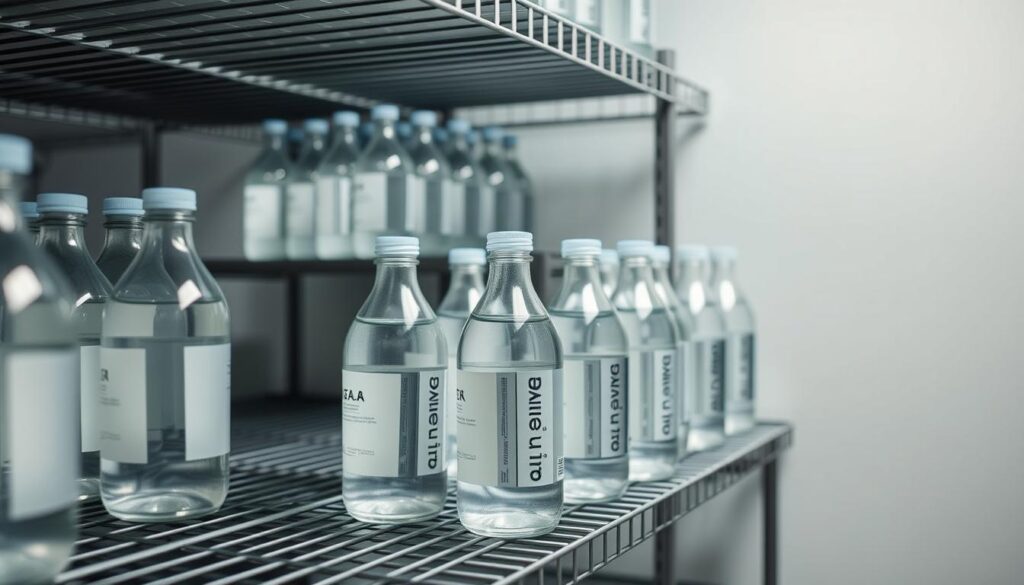
How to Test and Maintain Distilled Water Purity
To keep distilled water pure, it’s vital to understand the methods for testing and maintaining its quality. Regular testing and proper handling are crucial for maintaining distilled water purity. This ensures that the water remains safe and effective for its intended use.
Simple Home Testing Methods
There are several simple methods to test the purity of distilled water at home. These include:
- Using a TDS (Total Dissolved Solids) meter to measure the concentration of dissolved solids.
- Conducting a pH test to ensure the water’s pH level is within the acceptable range.
- Visually inspecting the water for any signs of contamination or sediment.
When to Discard Stored Water
It’s essential to know when to discard stored distilled water to prevent using contaminated water. Signs that indicate the water should be discarded include:
- Visible sediment or cloudiness.
- Unusual odor or taste.
- Exposure to contamination sources.
Regularly checking stored water against these criteria helps maintain its purity.
Transferring Between Containers Safely
When transferring distilled water between containers, it’s crucial to do so in a way that minimizes the risk of contamination. This involves:
- Using clean equipment and containers.
- Avoiding contact between the water and potential contaminants.
- Sealing containers properly after transfer.
Dealing with Emergency Contamination
In the event of contamination, it’s vital to act quickly. This may involve re-distilling the water or discarding it if the contamination is severe. Having a plan in place for emergency situations helps ensure that the purity of the distilled water is maintained.
By following these guidelines, individuals can ensure their distilled water remains pure and safe for use.
Conclusion: Best Practices for Long-Term Distilled Water Storage
Properly storing distilled water is crucial for maintaining its purity and quality. By following the guidelines outlined in this article, you can ensure that your stored distilled water remains safe and effective for its intended use.
To recap, the key to successful long-term storage lies in choosing the right containers, preparing them correctly, and storing them in optimal environmental conditions. Best practices for storing distilled water include using containers made from suitable materials, minimizing contamination during filling, and sealing containers effectively.
Preserving distilled water quality also involves regular testing and maintenance. By adopting these best practices, you can confidently store distilled water for extended periods, knowing it will remain pure and ready for use when needed.
Whether for drinking, laboratory use, or other applications, applying these guidelines will help you maintain the quality of your distilled water, ensuring it serves its purpose effectively.

